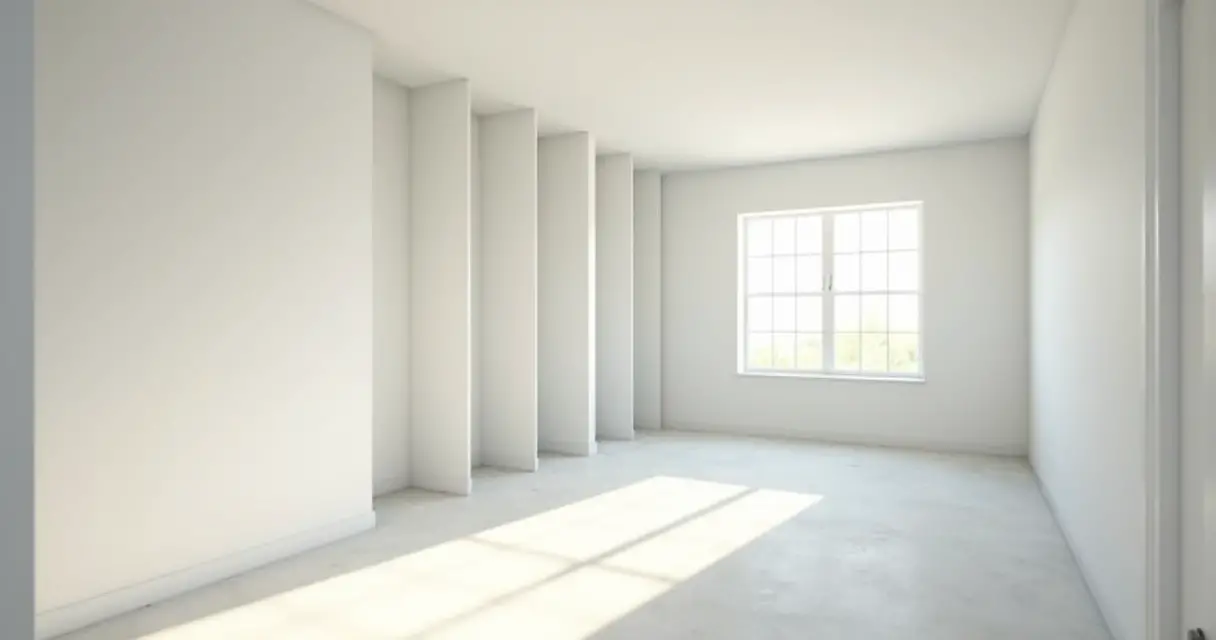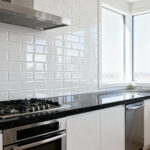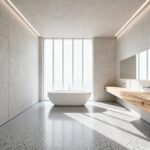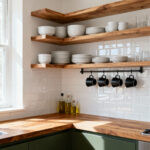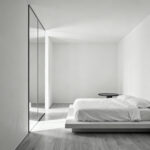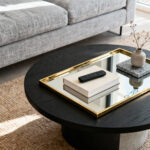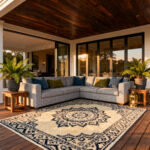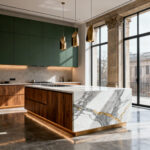You know what drives me absolutely bonkers about most mudroom designs I see online? They’re treated like a throwaway space. People either stuff it with ugly wire shelving and call it a day, or they create these pristine, all-white locker systems that look like they’ve never seen a muddy boot in their life. It’s either pure function with zero form or pure form that’s afraid of function. And from an environmental and a design standpoint, that’s just a massive waste.
The truth is, this space—the collision point of your messy life and your clean home—is one of the most important zones you have. It’s where you can stop dirt, allergens, and clutter dead in their tracks. It’s a workhorse. So, let’s talk about how to make it a beautiful, sustainable workhorse that actually makes your life easier and your home healthier. This isn’t just about pretty storage bins; it’s about creating a system that works for you and for the planet.
Smart Planning & Layout Foundations (Part 1)
Before you even think about picking out hooks or paint colors, we need to talk about the blueprint. This is the part everyone wants to rush through, but getting the foundation right saves you so much headache and money down the road. It’s about understanding how you actually live in the space, not just how you want it to look on Instagram.
1. Assess Your Space and Traffic Flow for Optimal Placement
First things first: stop looking at floor plans and start watching your family. Where does everyone dump their stuff the second they walk in the door? That’s your chaos point, and our job is to design a solution for it, not fight against it. Don’t put the shoe bench on the opposite wall from where the kids naturally kick off their sneakers. You’ll spend the rest of your life moving shoes two feet to the left. It sounds simple, but I see clients fight this battle all the time.
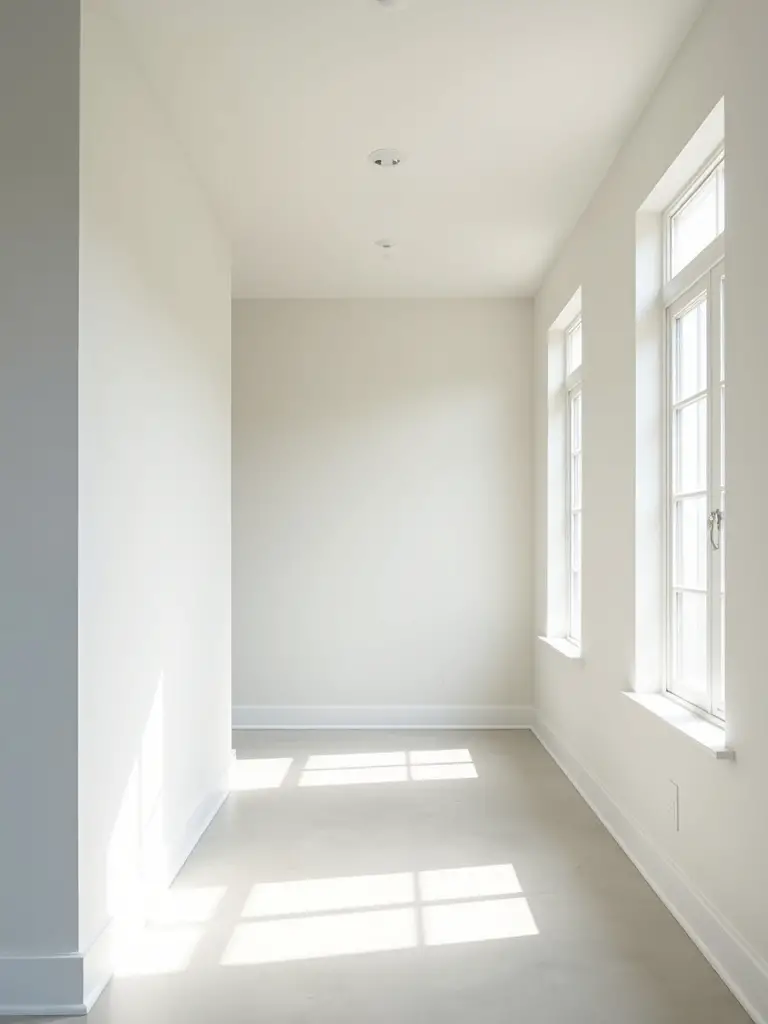
The big shortcut here is to use masking tape. Literally tape out on the floor where the washer, dryer, bench, and storage will go. Then, for a day or two, live with it. Walk through carrying an imaginary laundry basket. Have the kids come in from outside. You’ll immediately feel where the bottlenecks are. This five-minute trick has saved people thousands on renovations because they catch a major flow problem before a single cabinet is ordered.
Thinking about flow first isn’t just about convenience; it’s about creating a home that supports your well-being instead of causing subconscious stress.
2. Define Core Functions Beyond Laundry to Maximize Utility
Everyone gets this wrong. They think, “This is the mudroom and laundry room.” End of story. But that’s such a limited view! This is your home’s operational headquarters. Does it need to be a pet station, with a spot for the leash and food bowls? A command center with a calendar and a place to charge phones so they don’t die on the kitchen counter? A gardening hub with a utility sink for rinsing muddy hands and tools?
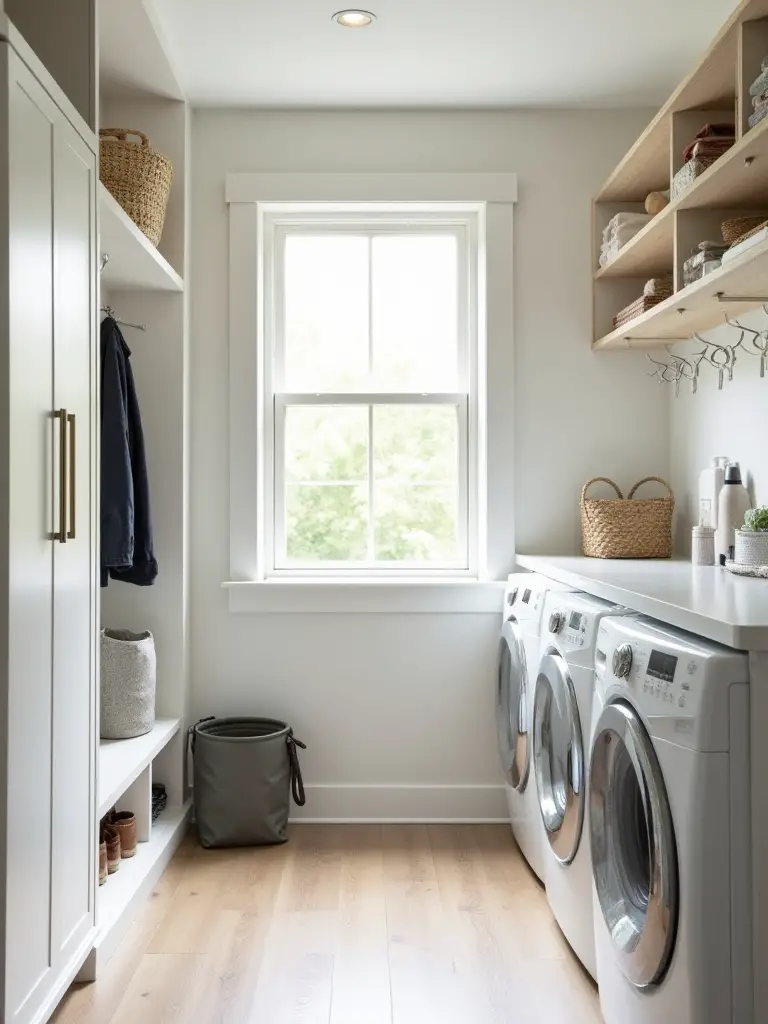
I worked with a family whose kitchen island was constantly buried under backpacks, mail, and permission slips. We built a simple “command center” into their mudroom—just a small counter with outlets and a bulletin board. It wasn’t a huge addition, but it completely reclaimed their kitchen. The secret is to solve the problems you actually have. Make a list of all the clutter piles in your house; I guarantee most of them can find a permanent home in a well-designed utility space.
This is your chance to stop clutter before it even starts, making the rest of your home feel more peaceful and organized without any extra effort.
3. Integrate Efficient Plumbing and Electrical Outlets Strategically
This sounds boring, I know, but it is the absolute backbone of the room. Don’t let your builder or contractor just throw outlets where it’s convenient for them. You need to think like a user. Where will you actually plug in the iron? Do you want an outlet inside a cabinet for a cordless vacuum charger? You should absolutely have outlets with USB ports near your “drop zone” for phones and tablets. Planning this now prevents the ugly mess of extension cords later.
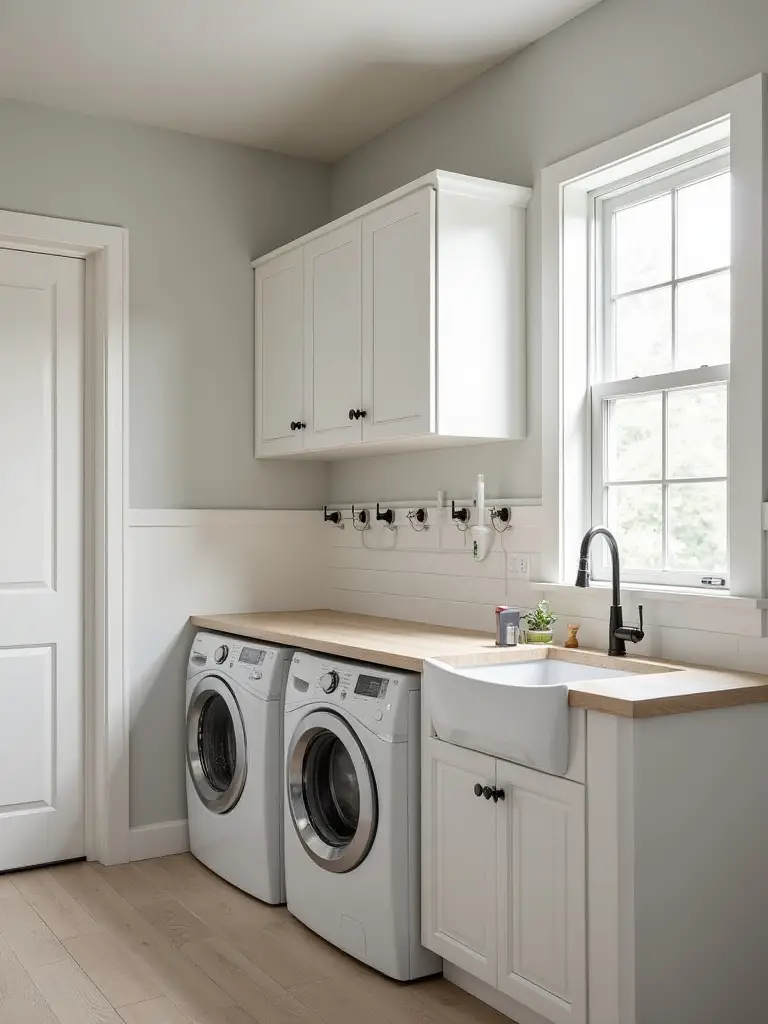
From a sustainability standpoint, this is also where you can make a huge impact. Consider a dedicated shut-off valve for the washing machine that’s easy to access. A tiny leak can waste thousands of gallons of water and cause catastrophic mold damage. I always recommend installing a smart leak detector, like a Flo by Moen. It’s a small investment that gives you peace of mind and protects your home from water waste and damage, which is a massive win for both your wallet and the environment.
Getting these unseen details right is the difference between a room that just looks good and one that truly works good.
4. Design an Optimized Layout for Smooth Workflow Transitions
Let’s talk workflow. Think of your mudroom laundry like a little factory assembly line. The process should flow in one direction: Dirty -> Clean. Dirty things come in the door (coats, shoes, laundry) and land in their designated spot. From there, laundry moves to the washer, then the dryer, then a folding counter, and finally into baskets to go back to its home. The goal is to minimize steps and backtracking. You should never have to walk across a pile of muddy shoes to get clean clothes out of the dryer.
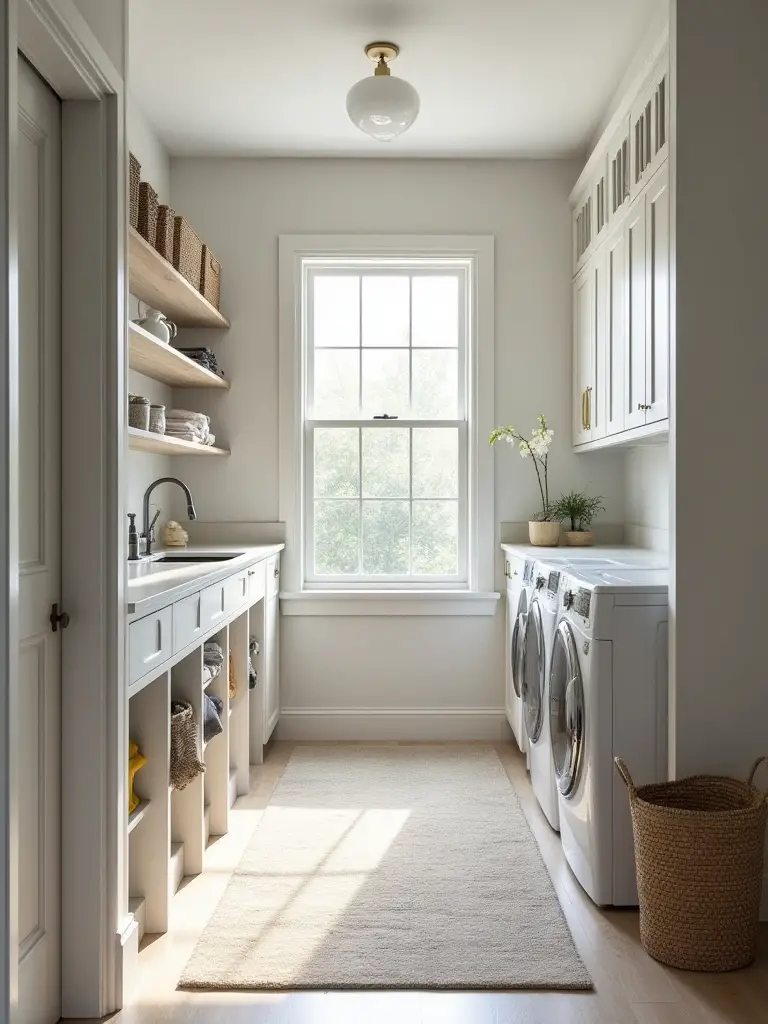
The big myth is that you need a huge room for this. You don’t. You just need a logical layout. A stacked washer and dryer can save you critical floor space for a folding counter right beside it. I had a client with a long, narrow room. We put the drop zone at one end, the laundry machines in the middle, and a full wall of floor-to-ceiling storage at the other. Everything moved in a straight, efficient line. It felt organized because it was organized, logically.
This isn’t about rigid rules; it’s about making your daily chores feel less chaotic and more mindful.
Smart Planning & Layout Foundations (Part 2)
Okay, now that we’ve mapped out the flow and function, let’s talk about the stuff the room is actually made of. This is where my environmental science background gets really excited, because your choices here have a huge impact on your home’s health and the planet. Durability is the ultimate form of sustainability. The longer something lasts, the less waste we create.
5. Choose Durable Flooring and Wall Finishes for Longevity
This room will see more water, dirt, and abuse than almost any other space in your home, so this is not the place to cheap out on materials. Forget about materials that can’t handle moisture. The industry BS is selling trendy-but-impractical options. Instead, think long-term. Large format porcelain tile with Epoxy grout is my gold standard—it’s nearly indestructible, waterproof, and won’t harbor mold. Another fantastic eco-friendly choice is Cork flooring. It’s naturally antimicrobial, water-resistant, and feels warm and soft underfoot.
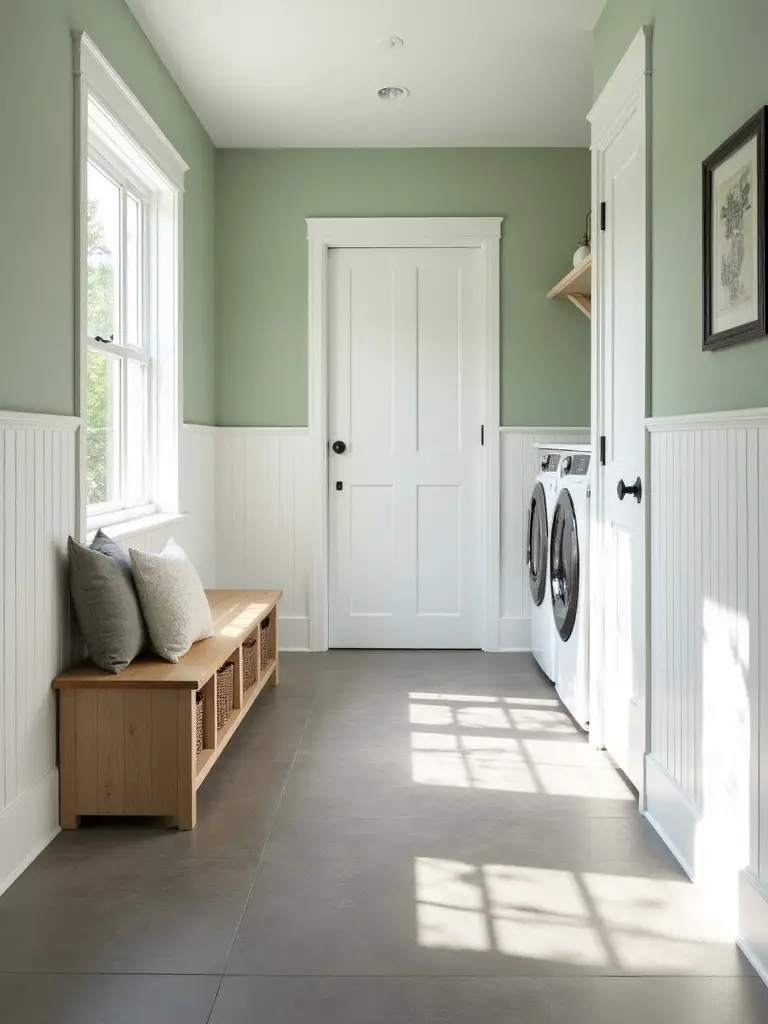
For walls, don’t just use standard flat paint. Go with a semi-gloss or satin finish that you can easily wipe down. Even better, install wainscoting or tile on the lower half of the walls. It creates a durable, waterproof barrier right where splashes, scuffs from bags, and muddy boots are going to hit. I love using reclaimed wood for this, sealed with a low-VOC finish. It adds incredible character and keeps perfectly good material out of the landfill.
Think of these surfaces as the frontline defense for your home, protecting it from the daily onslaught of life.
6. Maximize Vertical Space with Built-In Solutions for Storage
Here’s the deal: floor space is precious, but most people have acres of unused real estate on their walls. Go vertical! Taking cabinets and shelving all the way to the ceiling is the single best trick for maximizing storage. That top shelf you need a step stool for? It’s perfect for the stuff you only use a few times a year, like seasonal gear, bulk paper towels, or that turkey roasting pan.
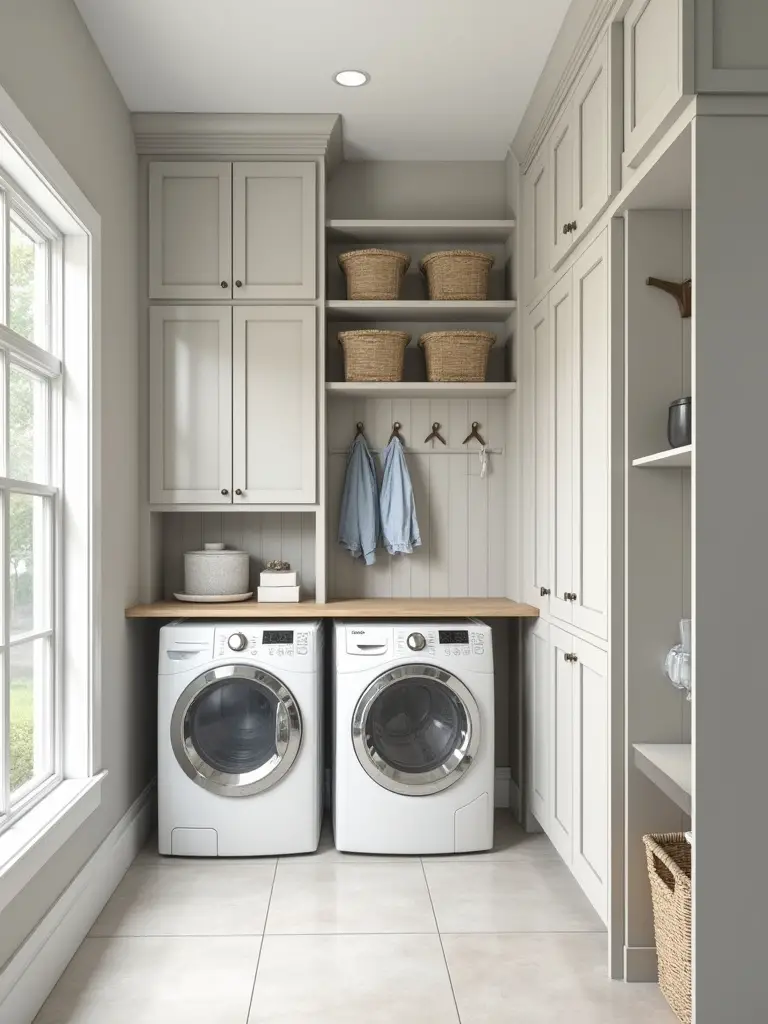
The mistake I see is people buying a bunch of mismatched, short storage units that just create visual clutter and leave a dust-collecting gap at the top. A cohesive, floor-to-ceiling system looks intentional, clean, and holds way more than you think. This doesn’t have to mean expensive custom cabinetry. Systems like IKEA’s PAX or ELFA from The Container Store are modular and can be configured to fit your space perfectly, giving you that custom feel without the custom price tag.
It’s about making every single inch of your room work for you, reducing clutter and creating a sense of calm and order.
Essential Fixtures & Storage Integration (Part 1)
Now for the fun part—the tools and fixtures that make the space work. These are the active components of your mudroom system. And again, every choice is an opportunity to be smarter, more efficient, and more conscious of our environmental impact.
7. Select High-Efficiency Washer and Dryer Units for Performance
This is a non-negotiable for me. If you’re buying new appliances, get Energy Star certified, high-efficiency (HE) units. Period. The marketing noise around fancy features can be distracting, but the real story is in the energy and water savings. An HE front-loader uses a fraction of the water and electricity of an old top-loader, which is kinder to the planet and your utility bills. My personal favorite sustainable choice is a heat pump dryer. They don’t require an external vent and use about 50% less energy than conventional dryers by recycling hot air. They’re a bigger investment upfront but pay for themselves over time.
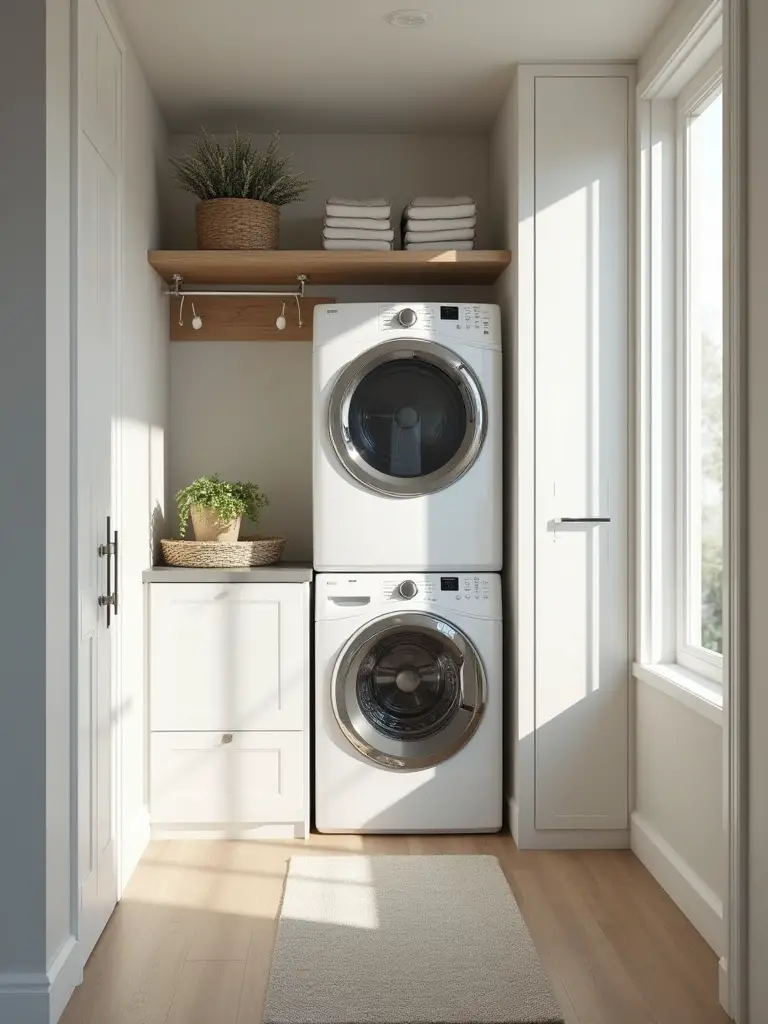
Don’t fall for the myth that HE machines don’t clean as well. That was true maybe 15 years ago. Today’s technology is incredible. The key is to use the right amount of HE-specific detergent—more is not better!—and don’t cram the machine full. Let the clothes move. Also, they’re much gentler on your clothes, which means your favorite sweater will last longer instead of ending up in a landfill.
Investing in efficient appliances is one of the easiest ways to reduce your home’s environmental footprint every single week.
8. Install a Functional Utility Sink for Convenient Handwashing
A deep, functional utility sink is the unsung hero of a hardworking home. It’s the buffer zone. It’s where you pre-treat grass stains, wash muddy hands, rinse out paintbrushes, or even give a small dog a bath. Putting a utility sink in your mudroom keeps all that mess contained instead of trekking it through the house to the kitchen sink, which should really be reserved for things you’re going to eat.
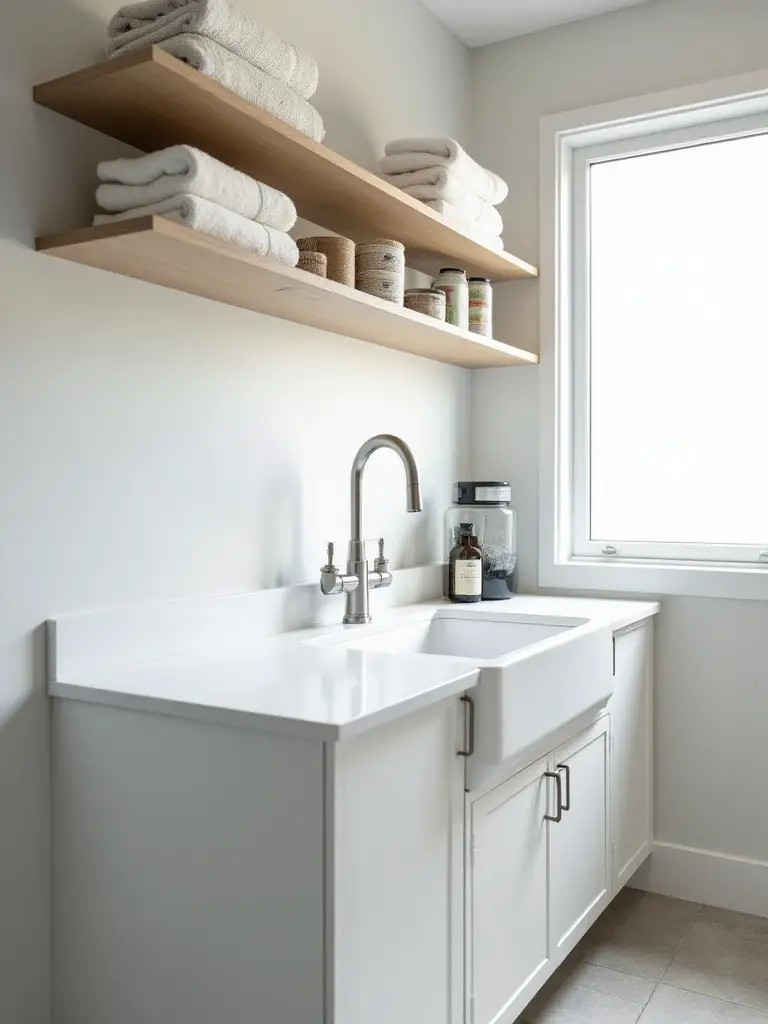
You don’t need a fancy, expensive model. A simple, deep basin made from stainless steel or durable polypropylene does the job perfectly. The real game-changer is the faucet. Get one with a high-arc and a pull-down sprayer. It makes rinsing boots, filling buckets, or cleaning the sink itself infinitely easier. A client of mine who is an avid gardener called her utility sink “life-changing” because she could process all her vegetables and clean her tools right as she came in from the garden.
It’s a simple addition that adds a massive amount of functionality and helps keep the rest of your home so much cleaner.
9. Incorporate Custom Cabinetry for Concealed and Organized Storage
“Concealed” is the magic word here. While I love some open shelving, the reality of a utility room is that you have a lot of ugly but necessary stuff: giant detergent bottles, boxes of trash bags, cleaning sprays. Custom or semi-custom cabinetry lets you hide all that behind a clean, cohesive facade. It instantly makes the space feel calmer and less cluttered.
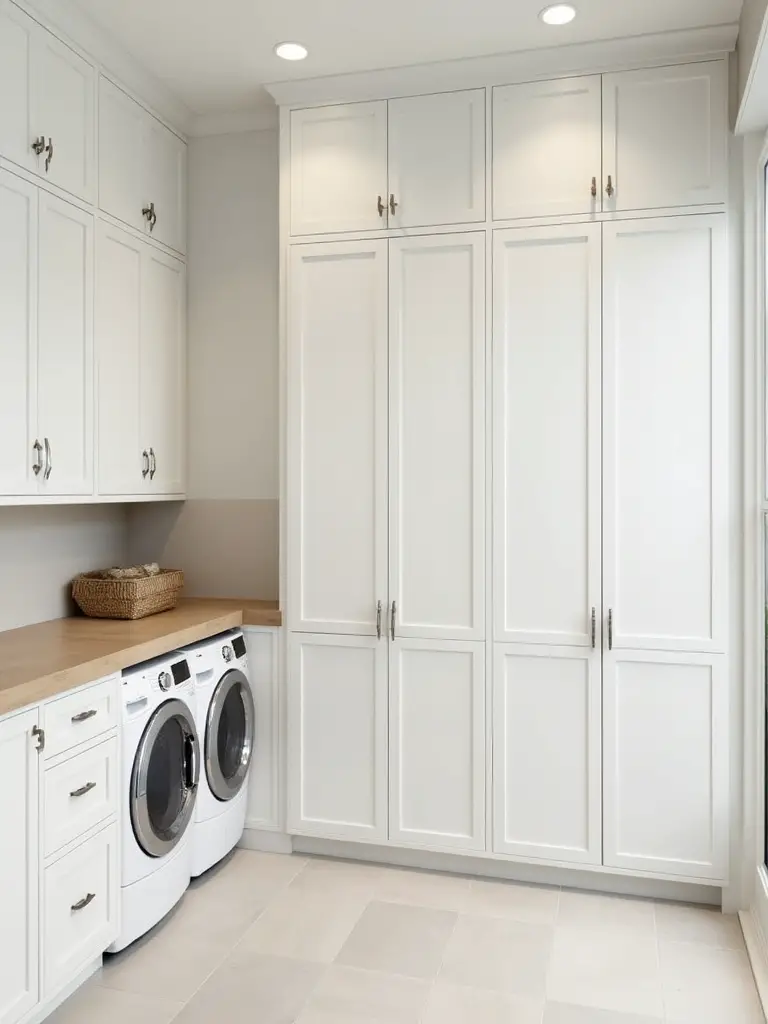
This is where you can get really clever. A tall, narrow pull-out cabinet next to the dryer is perfect for an ironing board or mops. A drawer with built-in dividers can organize batteries and lightbulbs. Toe-kick drawers beneath your lower cabinets can store things like shoe polish or extra sponges. Think about every annoyance in your current system and design a cabinet to solve it. This is how you create a space that feels like it was truly made for you.
“When everything has a designated home, tidying becomes effortless.” – Marie Kondo
Thoughtful, concealed storage isn’t about hiding a mess; it’s about creating a system so good that the mess doesn’t happen in the first place.
10. Utilize Open Shelving for Easy Access to Everyday Essentials
While cabinets are great for hiding clutter, open shelving is perfect for the items you use every day and for adding personality. This is where you put pretty glass jars of laundry pods, neatly folded towels, or baskets for keys and sunglasses. The rule is simple: if it’s beautiful or used daily, put it on an open shelf. If it’s ugly or used rarely, put it behind a cabinet door.
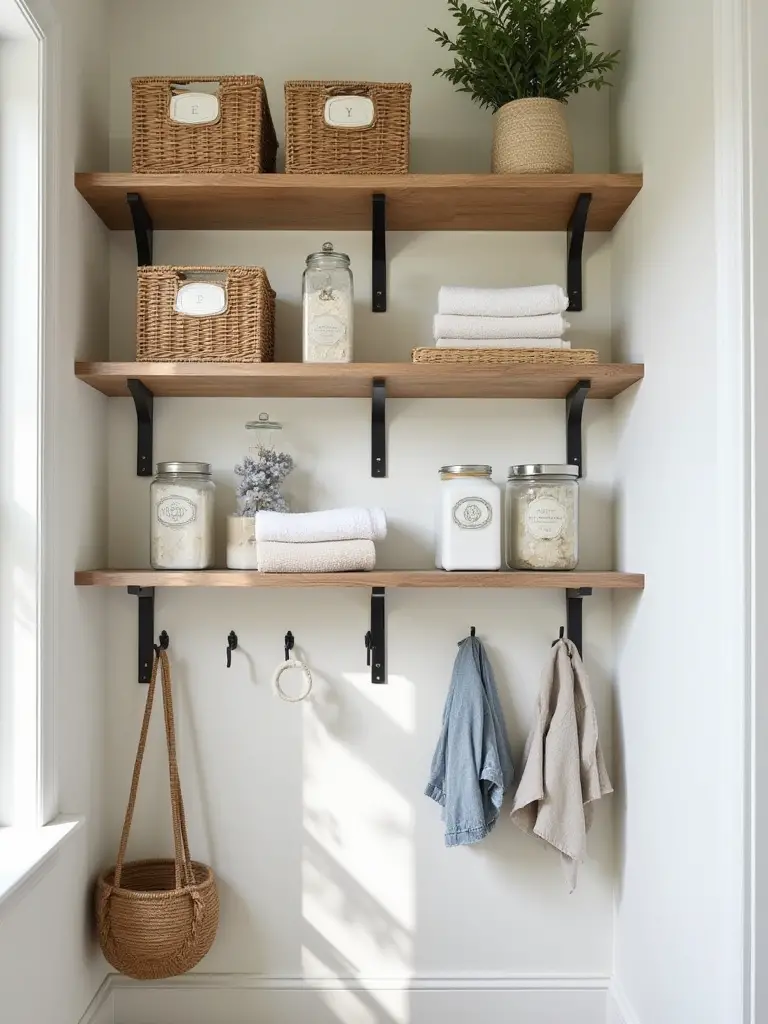
The biggest mistake people make with open shelving is cramming it full of mismatched junk. That just creates visual anxiety. The shortcut to making it look good is to use repetition and containment. Use a set of identical baskets or canisters. Decant your detergent into a beautiful drink dispenser. This isn’t just about aesthetics; it’s a mental trick. When your storage looks intentional and organized, you’re more likely to keep it that way.
Open shelving invites beauty and ease into a functional space, reminding you that even chores can be done in a pleasant environment.
Essential Fixtures & Storage Integration (Part 2)
We’re diving deeper now into the systems that truly prevent clutter and streamline your daily exit and re-entry rituals. These are the habits built into the design of the room. When you make it easy to do the right thing, people (even kids!) are more likely to do it.
11. Add Designated Drop Zones for Shoes, Coats, and Bags
A “drop zone” is the most critical system for an organized entryway. It’s a dedicated, intentional home for the three things everyone sheds the second they walk in: shoes, a coat, and a bag. This can be as simple as a sturdy bench with a boot tray underneath and a row of strong hooks above. The key is that it has to be right there, at the point of entry. Any further into the house is too late; the clutter bomb will have already gone off.
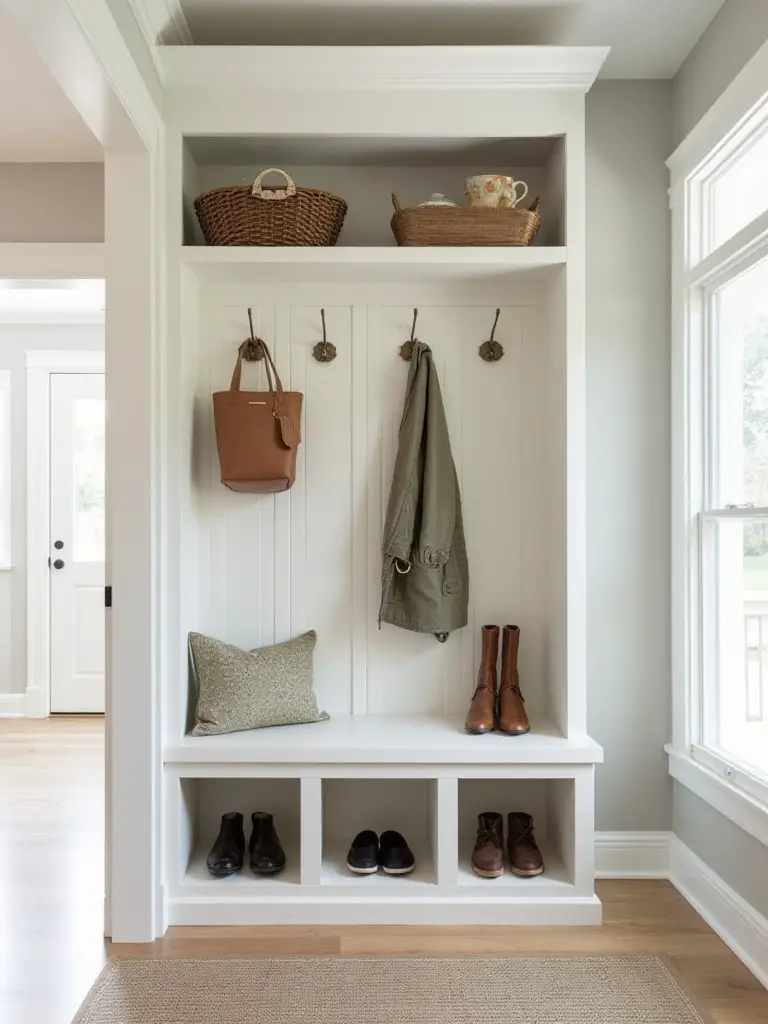
Everyone thinks they need a massive wall of custom lockers. You don’t. I’ve designed amazing drop zones in tiny closets. A bench with storage inside, a few hooks, and a small shelf for keys is all it takes. For kids, make sure the hooks are low enough for them to use themselves. You’re not just creating storage; you’re teaching a habit. By giving every item a logical and easy-to-access home, you eliminate the frantic “where are my keys?!” search in the morning.
This one simple concept will solve about 70% of the clutter that accumulates in your main living areas. It’s a game-changer.
12. Designate a Multi-Sort System for Efficient Laundry Pre-Sorting
Waiting until laundry day to sort clothes is a recipe for disaster. It creates a giant, overwhelming mountain of work. The fix is to build sorting into your daily routine. This can be a pull-out cabinet with three separate hampers (darks, lights, delicates) or even just a row of clearly labeled, beautiful baskets. As clothes get dirty, they go directly into the correct bin.
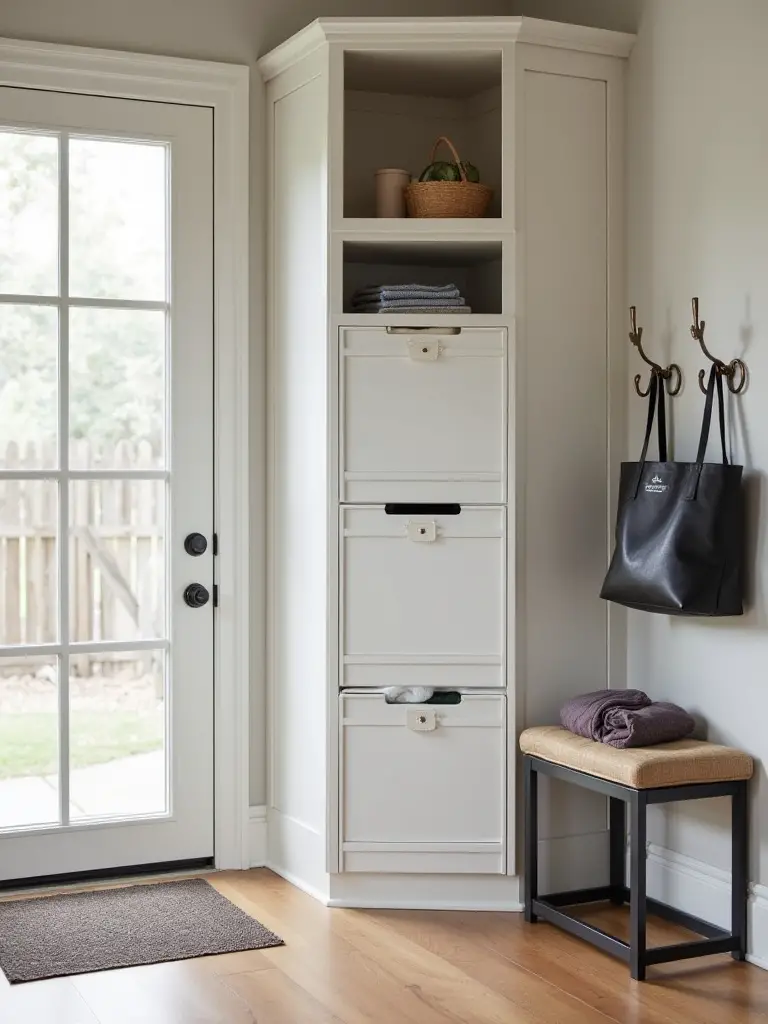
When it’s time to do laundry, you don’t have to think. You just grab the “darks” bin, dump it in, and press start. This is especially brilliant for families. I worked with one client to build a bench with four pull-out hampers—one for each family member. It was their responsibility to bring their hamper to the laundry room when it was full. It stopped the piles on the floor and distributed the workload.
This isn’t just about saving time; it’s about reducing the mental load of a never-ending chore, making laundry feel more manageable and less like a battle.
Enhancements, Style & Workflow Optimization (Part 1)
Alright, we’ve got the layout, materials, and core systems in place. Now we get to add the layers that make the space not just functional, but genuinely enjoyable and even more efficient. These are the details that elevate the room from a utility closet to a thoughtfully designed part of your home.
13. Integrate Smart Drying Solutions like Pull-Out Racks or Wall Mounts
Your electric dryer is one of the biggest energy hogs in your house. Anything you can do to reduce your reliance on it is a huge win for the environment and your budget. Smart drying solutions are the answer. Forget those clumsy, collapsible floor racks that are always in the way. I’m talking about sleek, wall-mounted accordion racks or pull-out drying drawers that disappear when you’re not using them.
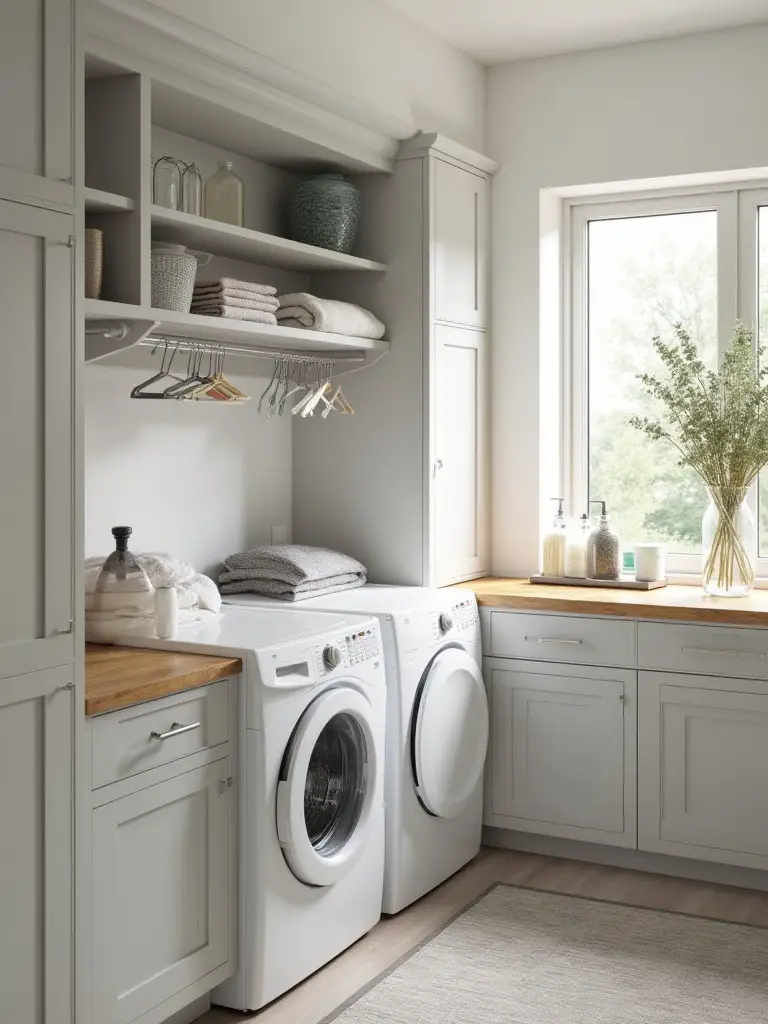
These are perfect for delicates, workout clothes (which shouldn’t go in the dryer anyway), or just giving items a head start before a short tumble in the machine. A friend of mine installed a simple, retractable clothesline over her laundry counter. It’s practically invisible when closed but gives her 15 feet of drying space when she needs it. It’s a low-tech, high-impact solution that saves energy and extends the life of her clothes.
Building in air-drying options is a fundamental part of creating a sustainable, modern laundry system.
14. Install Task-Specific Lighting for Clarity in Work Zones
One sad, dim ceiling light is not going to cut it in a room where you’re trying to spot stains on a white shirt. You need layered lighting. This means having good general (ambient) light from a central fixture, but also targeted (task) lighting right where you work. The easiest way to do this is with under-cabinet LED lighting over your folding counter.
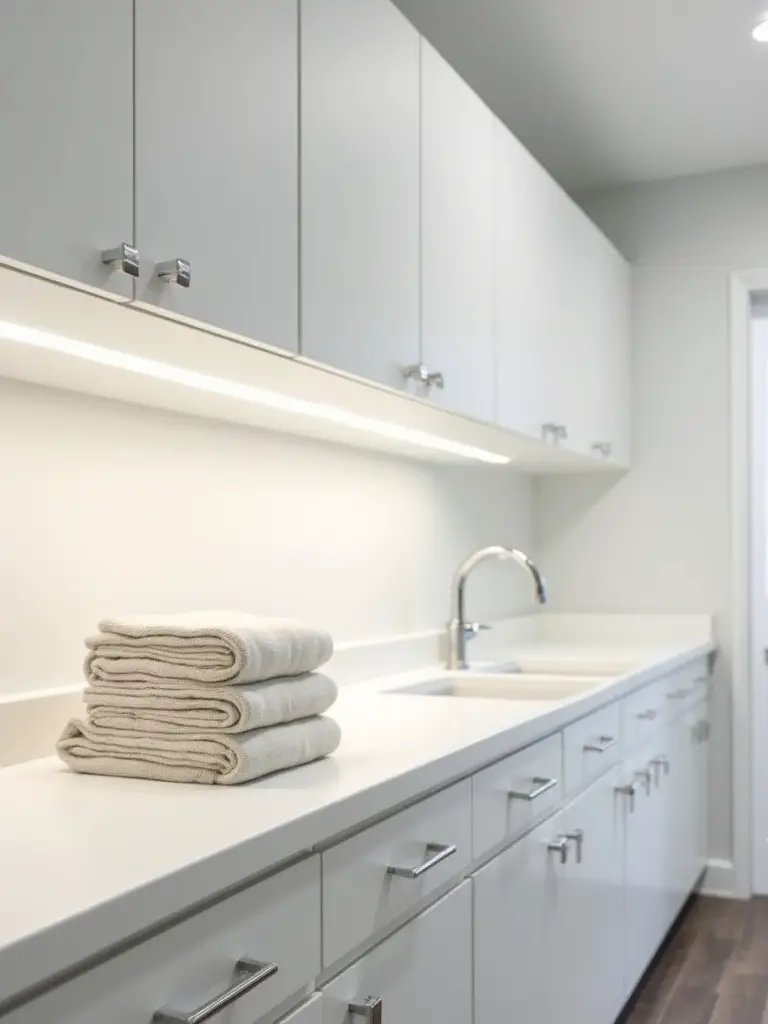
LEDs are the only way to go here. They use a fraction of the energy of other bulbs, last for decades, and provide clear, bright light that renders colors accurately. This isn’t just a nice-to-have; it’s a functional necessity. Good lighting reduces eye strain and helps you do a better job, whether you’re folding, mending, or treating a stain. It transforms the feeling of the space from a dingy basement corner to a bright, clean, and efficient workshop.
Don’t underestimate how much good lighting can improve your mood and motivation when tackling chores.
15. Select Durable and Stylish Countertops for Folding and Storage
You need a large, clear, flat surface for folding laundry. It’s that simple. Trying to fold clothes on top of the dryer is inefficient and frustrating. Your countertop here needs to be durable, smooth, and easy to clean. While granite and quartz are great, they can be expensive and have a significant environmental footprint due to quarrying and transportation.
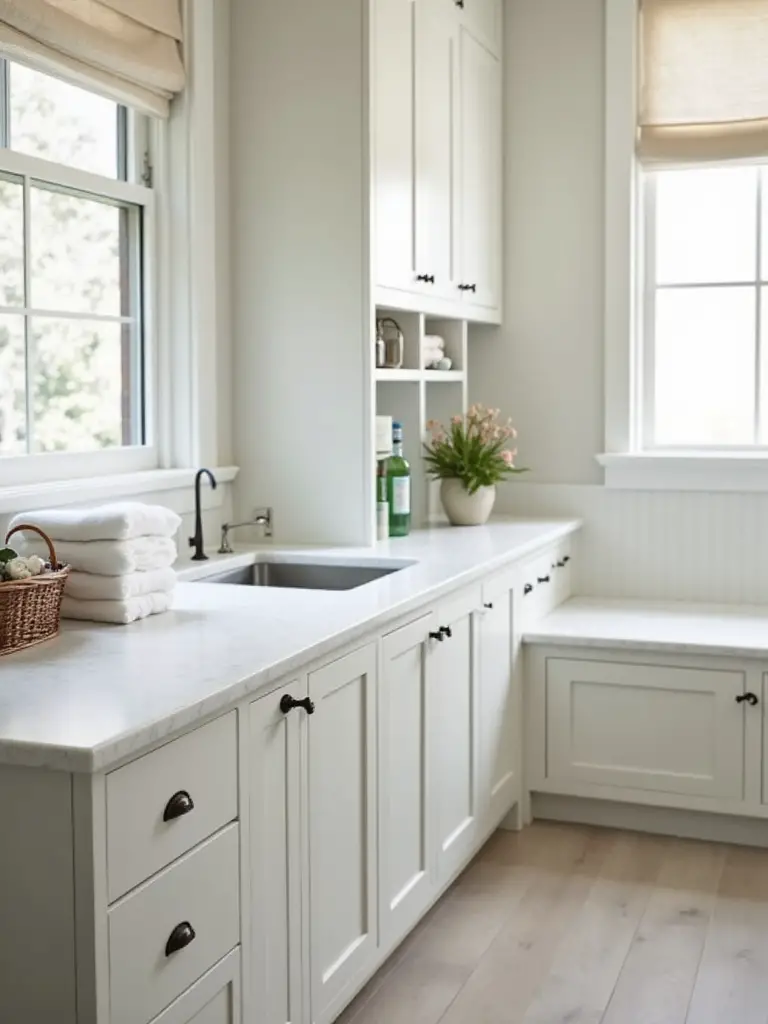
I often steer my clients toward more sustainable and budget-friendly options. A butcher block counter made from reclaimed or FSC-certified wood, sealed with a food-safe oil, brings incredible warmth and character to the space. Another excellent choice is composite countertops made from recycled paper or glass (like PaperStone or Vetrazzo). They are incredibly durable, non-porous, and a fantastic way to incorporate recycled materials into your home design.
This surface is your primary workspace, so choose a material that is not only beautiful but can stand up to years of service without contributing to environmental harm.
16. Personalize with Decorative Accents and Functional Hardware
This is the final touch, the jewelry of the room. Just because it’s a utility space doesn’t mean it has to be soulless. This is your chance to make it feel like your home. Swap out the boring, standard cabinet knobs for something with personality—maybe some beautiful brass pulls or modern matte black handles. Add a runner on the floor (make sure it’s durable and washable, like a Ruggable).
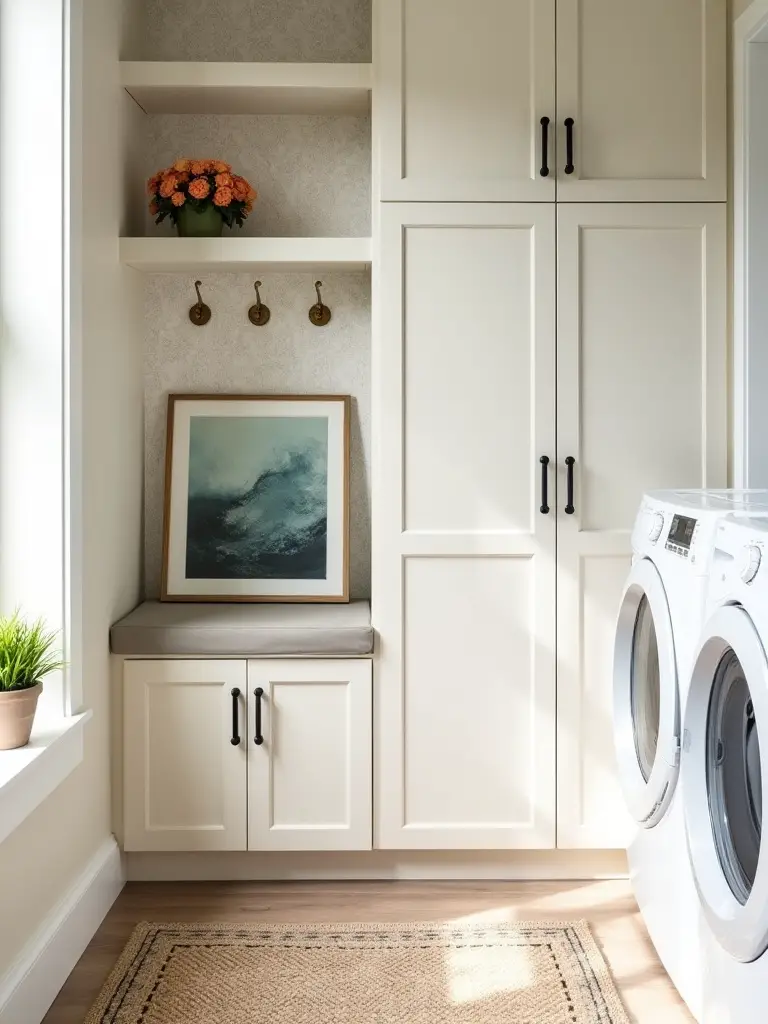
Hang some art on the walls! A beautiful print or a family photo can completely change the vibe of the room. Add a plant that loves humidity, like a fern or a pothos, to bring some life and natural air purification into the space. I once helped a client frame their kids’ “best” messy art projects and hang them in the laundry room. It was a perfect, personal celebration of the beautiful mess of family life.
These little details are what make a space feel loved and turn a chore room into a place you don’t mind spending time in.
Enhancements, Style & Workflow Optimization (Part 2)
Finally, let’s look at a couple of next-level enhancements. These might not be for everyone, but they solve specific problems beautifully and are becoming more common as we design homes that truly cater to every member of the family—including the furry ones.
17. Consider Creating a Convenient Pet Washing Station
If you have a dog, you know the pain of trying to wash them in the bathtub. It’s back-breaking, messy, and you end up with muddy paw prints all over the bathroom. Building a dedicated pet wash station in the mudroom is a stroke of genius. It can be as simple as a tiled-in, walk-in shower base with a handheld sprayer, or a raised, waist-high utility sink that saves your back.
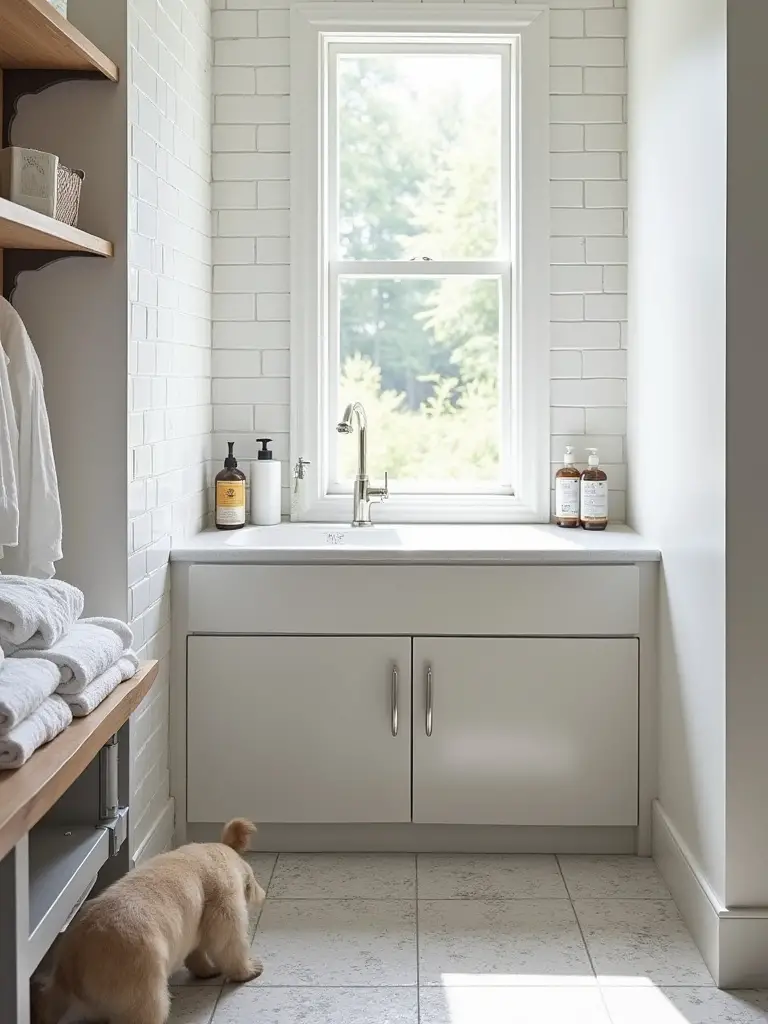
The key is containment. By washing the dog right at the point of entry, you stop that dirt and dander from ever making it into your home. This is huge for cleanliness and for anyone with allergies. Make sure to use non-slip tile and have hooks nearby for towels and leashes. This single feature adds tremendous value and functionality for the 70% of households that have pets.
It’s a perfect example of designing your home to solve your specific, real-world problems.
18. Optimize Airflow and Prevent Humidity with Proper Ventilation Systems
Last but certainly not least: you have to manage moisture. Dryers, utility sinks, and damp clothes create a ton of humidity, and humidity is the enemy. It leads to mold, mildew, peeling paint, and musty smells. Your home’s health depends on good ventilation. The building code minimum for an exhaust fan is often not enough. You need a quiet, powerful fan that is properly vented to the outside (never into the attic!).
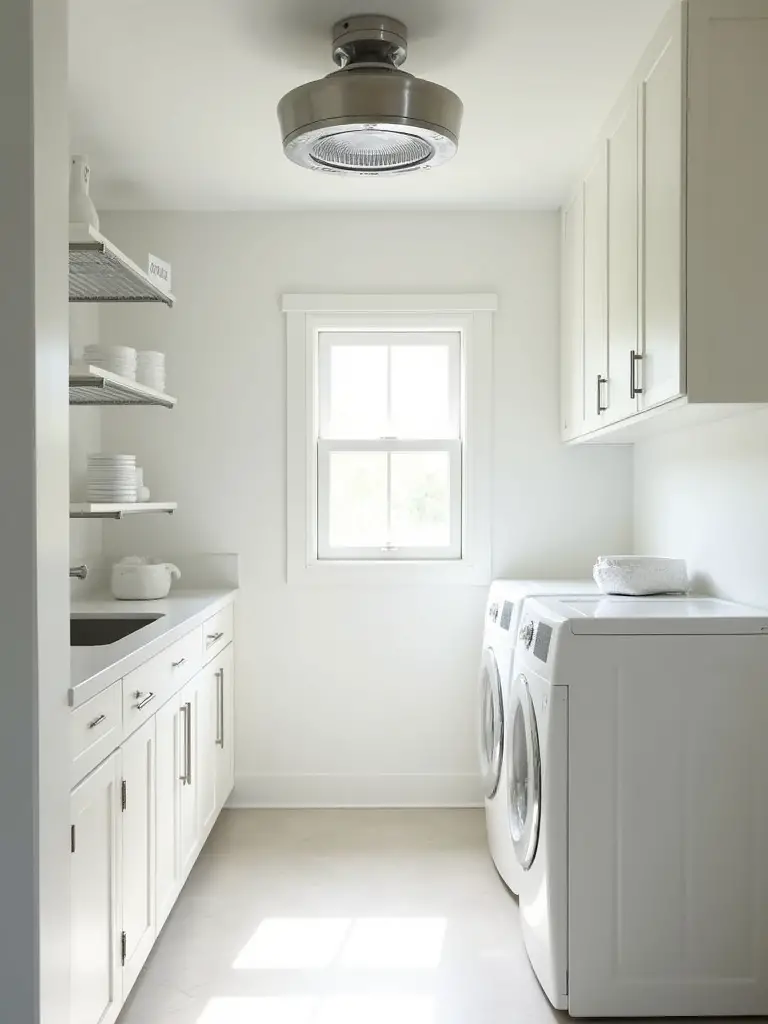
The absolute best practice is to get a fan with a humidity sensor (a humidistat). It will automatically turn on when the moisture level in the room gets too high and turn off when it’s back to normal. This means you don’t have to remember to flip a switch. It just works, silently protecting your home’s air quality and structure in the background. Also, make sure your dryer vent is a short, straight run of rigid metal ducting—the flexible foil ones are inefficient and a fire hazard.
This is the invisible system that keeps your beautiful new space healthy, fresh, and durable for years to come.
Conclusion
So there you have it. Creating a mudroom and laundry space that is beautiful, sustainable, and hyper-functional isn’t about having a massive room or a giant budget. It’s about being thoughtful. It’s about designing a system that stops clutter, streamlines chores, and supports a healthier, more organized life. By choosing durable, eco-conscious materials and designing a layout that matches the natural flow of your family, you can transform this workhorse space from a source of stress into a hub of calm efficiency.
Don’t feel like you have to do everything at once. Pick one or two ideas that would solve your biggest headache right now—maybe it’s just getting a proper drop zone set up or installing some task lighting. Small changes can have a huge impact. You have the power to make this essential part of your home work harder for you, so you don’t have to. Go create a space that makes your daily life just a little bit easier and a lot more beautiful.
